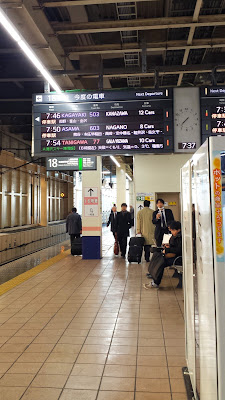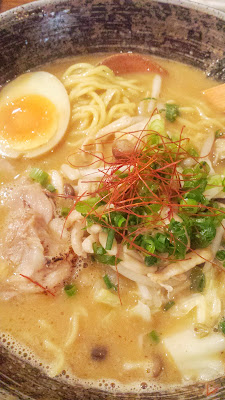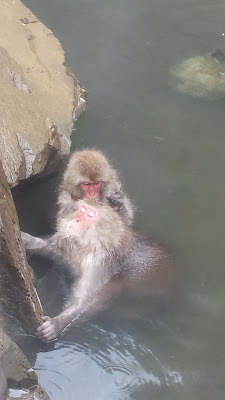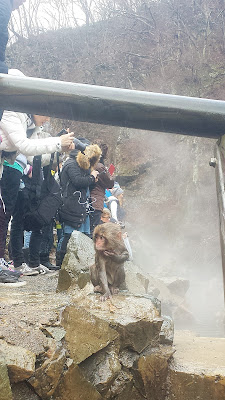One of the favorite things I did during my trip to Japan in December was visit the Snow Monkeys of Nagano. Specifically, there is an area called Jigokudani Snow Monkey Park (also known as Shigakogen, although the park is not in the ski resort area of Shiga Kogen but at the base of the Shiga Kogen region). At the park you can encounter wild Japanese macaque who while living up to their name in that they live in the mountains where there is snow, also find respite from the cold by bathing in natural hot springs. There are other various areas and attractions on Japan that also feature snow monkeys, but only Jigokudani Monkey Park has the additional bonus of the snow monkeys bathing in a spa.

Visiting Jigokudani Monkey Park is something you can easily do as a day trip from Tokyo, but it does involve a couple hours of travel time. You can also choose to stay in the area overnight, where besides seeing monkeys in hot springs, you can enjoy hot springs in onsen yourself in the nostalgic spa towns of Shibu and Yudanaka, or go skiing. Nagano is part of the four prefectures that make up the Japanese Alps with majestic peaks, multiple ski resorts, and seven cities full of sightseeing opportunities including Matsumoto Castle, Daio the largest wasabi farm, snow huts in Kamakura , or the Tateyama Kurobe Alpine Route you may have seen photos of with roads featuring towering 20 meter high walls of snow on both sides.
How To Get Here
You can take a tour from Tokyo to Jigokudani Monkey Park (地獄谷野猿公苑 Jigokudani Yaen Kōen) or if you have a JR Pass you may want to book the one from Nagano instead and get to Nagano yourself via JR bullet train, aka shinkansen, since that will save a lot of money with the pass. Or do as we did, and do everything on your own time.
Getting to Nagano should be pretty straightforward from Tokyo or whatever city you start from as the shinkansen tickets are easy to get with multiple times available and the tracks clearly labeled down to which car to get into if you have a reserved seat (the signs switch between Japanese and English). To look up train times, I used Hyperdia which is a website as well as an app to help search routes and times for transit everywhere in Japan.


For us, from Shinjuku where we were staying, we used our JR pass to travel 30 minutes to the station Omiya, which is a big shinkansen train stop. There, we then took a 1 hour shinkansen to Nagano with reserved seats that are free, again with the JR pass.


If you come on your own, once you arrive at Nagano, you can pay on your own for each transportation option, or for a savings, purchase a Snow Monkey 1 Day Pass at the station which gives you unlimited use of Nagaden buses and trains and includes the Snow Monkey entrance fee for 2900 yen for one day. This is a great option if you plan to make a whole day trip in Nagano since you can visit other attractions in the area, be it the ski resort or temples or what not. You can just pay for each leg individually too if you don’t have time to get the pass.
In terms of travel from the Nagano station to the Snow Monkey park, from here you have the option of either
- taking the private train Nagaden (Nagano Electric Railway, which is not covered by JR pass) to Yudanaka then a quick 7 minute bus to the Kanbayashi Onsen stop and walk up the hill to the park. At Nagano station, you must exit the station to enter the underground Nagaden Nagano Station, next to JR Nagano Station, to catch the local (70 minutes and has one transfer at Shinshu-Nakano Station along the way) or limited express (50 minutes, direct) to the cute Onsen town Yudanaka. This route has more transfers and takes longer, but service is more frequent than below and if you are going to other destinations like staying at a ski resort or onsen, this may be the most convenient for you. To use this bus, you use the same system as other Japanese buses where interestingly enough, you enter at the back door. In this case, you will grab a small, numbered, paper ticket from the machine just inside the entrance and sit down. Then when you get to your stop (you will have to push the Stop button to signal you want the stop), your fare is determined by matching the number on your paper with the sign over the front door. Pay at the machine next to the driver at that front door exit.
- you can take an express NagaDen bus from the East exit of Nagano station, Bus Stop #3 to the Kanbayashi onsen stop and walk up the hill to the park. This is a longer bus ride than the previous option, but you can go direct from JR Nagano station instead of more transfers. The bus ride is about 40 minutes – so overall, depending on your timing with the train and bus, it can be the faster option than even taking the Nagaden limited express train and more frequent local bus. How often the express bus runs varies – there are less buses per day in summer and but around 12 buses per day in winter. You can see the schedule here on the Nagaden Express Bus page (click on Shiga Kogen after translating the page – I used Chrome browser and Google Translate by clicking in the upper right url box to do the translation. This is also the first link in this content area of the linked page.) For Dec. 5, 2015 – April 4, 2016 this is the direct link to the schedule. This was the transportation option we took. The bus looks like any other limo bus, and you pay the fare with the bus driver when you exit at your stop.
Both ways still involve a bus, and you end up at the same Kanbayashi Onsen stop along the road. The small road you need to take if you face the gas station from the road is just to the left of the station.


From here you will have to walk from the Kanbayashi Onsen stop by the road to the gate (Snow Monkey Park signs try to help validate you are going the right way as you walk). This will be about .4 km towards the start of a short 1.6km trail through the woods, and then after the trail you will arrive at the park itself.



At the gate / right before the 1.6 km trail through the woods towards the park, there is a Snow Monkey Resorts Info & Gift Shop with monkey park souvenirs and which can also store your luggage and rent snowshoes or poles or winter gear like coats or purchase gloves, socks etc. to help you on your trek if you want. After you pay your admission, there are a few small lockers at the park entrance just past where you pay admission. The only restroom once you leave the train station is after the park entrance, right past a very small waiting area/gift shop.

The walking trail is passable around the year, but wear comfortable waterproof shoes you don’t mind getting dirty especially in winter because it gets covered in snow, or as during my visit was a combo of Rain and snow so it got muddy and could be slightly slippery at the trail edges. After we returned to Tokyo around mid afternoon, we had to go back to the hotel because our pants were covered with mud spots from our walk and we couldn’t really go anywhere with that mess on us. So, you may have to be prepared to not go to another destination right away depending on the state of your pants and shoes! It was nice to stretch our legs walking on the trail after the time on the train and bus though, and despite the mud and we were at least happy it wasn’t icy snow. The woods are full of tall ceder trees, and it goes uphill but not very steep so it’s a very easy walk.


After the trek through the woods, you will emerge to the small town Shibu-Yudanaka just outside the park. Almost there! Now it’s just a slight walk to the stairs of the actual park where you will pay admission. From Kanbayashi Onsen when you get off the bus, it probably a 30 minute walk total from street to the monkey park admission window, about 2 km.

From the admission gate, it’s only a 5 minute walk to the hot spring, although you can also walk around the path by the river where you might observe other non bathing snow monkey groups. It was very dramatic as we approached the hot spring bath because there was so much steam that we couldn’t see any of the snow monkeys at first – and then it blew away and there they were!
It was very dramatic as we approached the hot spring bath because there was so much steam that we couldn’t see any of the snow monkeys at first – and then it blew away and there they were!


There is also a live webcam set up manned apparently by a team of Monkey Supervisors.

One of the pluses of not going on a tour is that the crowd would ebb and flow clearly based on the presence and timings of tours. We were able to spend our own time here (about 1 1/2 hours once we were inside the park) so didn’t feel a need to rush. Even with a crowd though, everyone was very polite in taking turns in various good spots for photos (by the stairs for instance).
While you are waiting for the bus after you finish after you walk back, consider stopping by Enza Cafe for a bite to eat. They also offer free wireless, and it’s one more clean restroom stop before the bus. You can pay by credit card or cash here. They had a warming Zenkoji-Miso Ramen featuring local miso, and even vegetarian options such as fried sweet potato and an odd vegetarian roll that was like Lettuce, Tomato, and mayo sandwich with rice and soy sauce and seaweed instead of bread…?!



Background
Snow Monkeys are endemic to Japan. They are given this moniker because there is no other non-human primate that lives so North and in such cold climates. With snowfall covering the ground where they would normally be foraging for food, this limits their diet to more meager buds, bark, and dirt for minerals and relying on energy stored from the autumn season. In the winter, the snow monkeys also huddle together for warmth from temperatures that could dip to 14ºF (-10ºC), but the tribes in Jigokudani area fortunate in their territory in that they also have the hot spring baths.


Jigokudani is located in the northern part of Nagano prefecture at an altitude of 850 meters. Jigokudani translates to Hell Valley because of the very steep cliffs, the fact that it is usually buried in snow 1/3 of the year, and there is constantly steam coming off of the springs. The Snow Monkey Park of Jigokudani is in the valley of the Yokoyu River, downstream from Shiga Heights and upriver from Shibu-Yudanaka Onsens.


The Jigokudani Snow Monkey Park was established around 1964 and has one man made pool and entices the wild monkeys to visit sometimes with feed comprised of barley with chaff, soy beans, or apples. However, visitors are not allowed to feed the monkeys as they are completely wild and may terrorize you and based on which monkeys are fed it can cause conflict among the monkey tribe if you don’t respect the rank order – better leave it to the experts. Both males and females have status rankings to establish dominance, and the youngest offspring of high ranking females inherit their mother’s ranking.
The park is open all year round. Since the monkeys are wild, there is never any guarantee of seeing the monkeys, though there are about 200 in the area and during the coldest periods (December – February) your chances are higher they will be drawn to the hot springs from the forests in the area which is their regular home. Besides the hot springs, the monkeys at Jigokudani are a draw because they have become very used to people and ignore them – just make sure you don’t look at the monkeys straight in the eyes, as that is taken as hostile action! Their faces are so expressive that you can see why they have a lot of weight in faces and not just body language.
Careful focus on arm washing, followed by a judge-y look it seems…?
Since the snow monkeys here are a full natural troop in the wild, the longer you visit you can start to observe their societal hierarchy and relationships, which is why I prefer visiting on my own rather than on a tour that limits your time here. There are no bars in your way, and the monkeys come and go as they please as there are no gates or fences and so you could encounter them anywhere along the way in the park or even a bit outside the park. You can observe them so meticulously groom themselves as they bathe individually, or in a group helping each other out get to the hard to reach places.
Some zen out lost in their own thoughts it seems.

There are babies everywhere.

The snow monkeys hang out everywhere – in the water, on the rocks, even right next to you on the railings without a care for the paparazzi around them. Though it did seem one particular monkey was posing on purpose…
It’s truly hard to not be charmed by them each individually – or in their groups. These two were snuggled like this the whole visit, demonstrating the definition of how close 2 individuals can snuggle.
It took up 3/4 of a day for us to make this trip – we arrived at Nagano in time for one of the two 9:05 AM buses, so we arrived at Jigokudani around 10:15 AM and we left around to catch the 12:50 bus so that we were back in Tokyo by mid-afternoon to relax as I wrote snow monkey postcards before we went out for Winter Illuminations (I covered that in a previous Japan Travel post) and dinner. It made for an early morning which is why I picked it early on in our trip – and there was no snow that stuck in our mid December visit although it did snow, and we saw snow at higher elevations above us. This excursion is one of the favorite things I did in Japan as it is so unique to Japan and many visitors to Japan don’t take this trip.
More Info on Jigokudani Snow Monkey Park
- Official Jigokudani Snow Monkey Park Website
- Nagano Japan Snow Monkey Resorts website lists multiple activities and options in the area
- Japan Guide: Jigokudani Monkey Park
- Go Nagano which also has additional information about things to do in the Nagano area
- Nagaden has an information book that has an information guide book you can see among the offerings in their banner on their home page
- More great photos showing the snow monkeys as well as the path to the park via Google Maps – Jigokudani Monkey Park
Have you heard of the Snow Monkeys of Japan before? Would you make this a stop on your visit in Japan, or was one of the other options I mentioned earlier in the Japanese Alps be more interesting? Have you heard of the Japanese Alps before? Is there an animal that you would be willing to spend a half day or more especially to go visit when you are travelling?
Seeing the Snow Monkeys enjoying the hot springs made me want to enjoy one too… And I’ll cover human Onsen in my next Travel Tuesday post.
Here’s a summary of my Japan Travel post series:
- Guide to Planning a Trip: Research
- Guide to Planning a Trip: Mapping
- Hagoita Ichi Winter Festival at Sensoji Temple, Japan
- Japanese Treats at Temples and Shrines
- Winter Illuminations in Tokyo (Winter Season – November – February!)
- Snow Monkeys in Hot Springs
- Onsen by Mount Fuji covers Onsen 101 and how we loved our stay at Lake Kawaguchiko
- Dining at a Ryokan a look at what a traditional dinner and breakfast might be during a ryokan stay
- Visiting Cup Noodles Museum in Yokohama (just outside Tokyo)
- Visiting Shin Yokohama Ramen Museum
- Kyoto Temples and Shrines (walking tour starting in Higashimaya with stops especially at Kiyomizudera Temple, Kodaji Temple, Heian Shrine)
- Kyoto Temples in Arashiyama
- Kyoto Tofu
- Kyoto Famous Sights of the Kinkakuji (The Golden Pavilion) and Fushimi Inari (Red Torii Gates)
- Famous Signs of Osaka and eating Osaka Food specialities like okonomiyaki, takoyaki and kushikatsu
- Visiting Himeji Castle, the famous white castle in Japan
- Fun at Japanese Cafes and More including Maid Cafe, Cat Cafe; theme parks of J World and Namja Town, a geeky stop at Kanda Myojin, and Ghibli Museum
- Japan Eating Checklist is my top 25 list of things to try to include as an eating experience when visiting Japan
- New Year’s in Japan: Oji Fox Parade, and some photos of a Meiji Shrine visit on New Year’s Day







